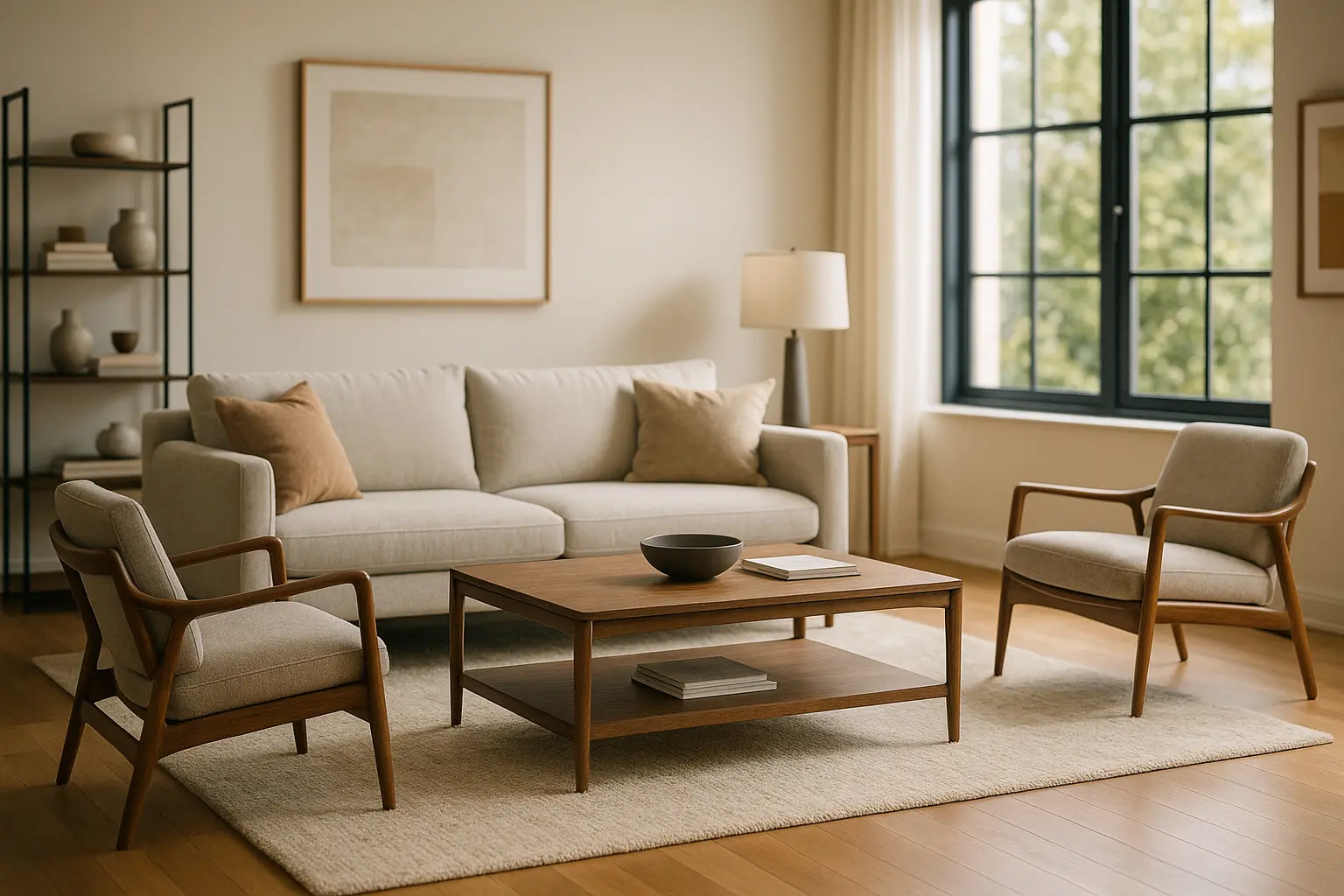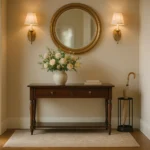Creating a living space that is both aesthetically pleasing and functional may seem daunting at first glance. We often find ourselves overwhelmed by the myriad of choices in furniture styles, colors, and layouts. With all these choices, crafting a cozy yet stylish room isn’t just about finding the right pieces; it’s about knowing how to bring them all together seamlessly. We believe that with a few fundamental rules in mind, anyone can transform their rooms into inviting, well-designed sanctuaries.
In this article, we take you through five essential rules that will not only fill your space with character but also strike the perfect balance between form and function. From selecting the perfect sofa to creating focal points, let’s explore how you can make your living space truly shine.
Rule 1: Start with a Focal Point
When we step into a room, our eyes naturally seek a focal point — a feature that draws our attention and anchors the space. For some, this might be an ornate fireplace, while for others, it could be a striking piece of art or a large window with a breathtaking view. As designers of our own homes, it’s crucial to identify and enhance these focal points, as they set the tone for the overall design.
Creating a focal point isn’t just about choosing the most eye-catching item in the room. Instead, it’s about intentionally positioning elements in a way that highlights this feature. Let’s delve into a few strategies to achieve this:
- Highlight with Lighting: Use strategic lighting to enhance your focal point, drawing attention to its unique features and textures.
- Positioning Furniture: Arrange your furniture — especially key pieces like the sofa or table — so they face the focal point, creating an engaging and cohesive environment.
- Use Contrast: Employ contrast by using bold colors or textures around your focal point to make it stand out in the space.
With a well-defined focal point, the rest of your room falls into place more easily, allowing every element to complement and enhance the chosen centerpiece.
Rule 2: Consider the Room’s Functionality
Every room serves a unique purpose, and understanding each space’s functionality can guide our design choices. It’s essential to ask ourselves what activities will take place in the room. Will it be a cozy seating area for relaxed conversations, a dynamic hub for entertainment, or perhaps a tranquil study nook?
Once we’ve identified the primary purpose of the space, we can define the layout to support these activities effectively. Let’s explore how functionality influences design:
- Choose Multi-Functional Furniture: Opt for pieces that can serve dual purposes, such as a coffee table with storage or a sofa bed.
- Define Zones: Create distinct zones within larger spaces using rugs, chairs, or partitions to delineate areas for different activities.
- Ensure Flow: Arrange furniture to allow smooth movement throughout the room, ensuring pathways are unobstructed.
By focusing on the room’s intended use, we ensure that the layout not only looks good but also enhances daily living by supporting our lifestyle.
Rule 3: Balance and Proportion
Striking a harmonious balance and maintaining proper proportions are key to achieving a visually pleasing layout. A balanced room feels calm and ordered, while one that’s disproportionate can appear chaotic and crowded. The beauty lies in the details—how each piece fits and interacts with the rest of the space.
To master balance and proportion, consider these aspects:
- Symmetry vs. Asymmetry: Symmetry brings a sense of order and formality, often achieved by mirroring elements on either side of a central axis. Asymmetry, on the other hand, can add dynamic interest by balancing different pieces in a more relaxed way.
- Scale of Furniture: Choose furniture that matches the room’s dimensions. For example, a large sectional might overwhelm a tiny space, while a petite sofa could get lost in a large room.
- Visual Weight: Balance the visual impact of heavier items, like a dark cabinet, with lighter elements, such as airy curtains or glass tables.
By thoughtfully considering balance and proportion, we create rooms that feel cohesive and comfortable, elevating the design to new heights.
Rule 4: Mix Textures and Materials
Incorporating a variety of textures and materials is an art that can transform a room from mundane to mesmerizing. When done with finesse, mixing different textures adds depth and dimension, creating a rich tapestry of elements that appeal to both the eye and the touch.
Here’s how to skillfully blend textures and materials in your living space:
- Contrast Soft and Hard Materials: Pair soft, plush textiles like velvet or wool with hard surfaces like metal and wood to create visual and tactile contrast.
- Layer Textures: Introduce multiple layers of texture through furniture, wall treatments, and accessories, such as woven throws, smooth leather chairs, and glossy ceramics.
- Consistency in Color Palette: While mixing textures, keep a consistent color scheme to maintain cohesion and avoid overwhelming the senses.
By embracing a diversity of textures, we can create spaces that feel inviting and alive, encouraging us to linger and explore.
Rule 5: Allow for Breathing Space
While it’s tempting to fill every corner with beautiful furniture, allowing for breathing space is crucial in crafting a serene environment. An overcrowded room can feel suffocating, while a well-edited space offers a sense of calm and openness.
To ensure our living spaces breathe, consider these tactics:
- Mindful Arrangement: Leave pathways clear and ensure no piece of furniture obstructs the flow of movement in the space.
- Embrace Minimalism: Opt for fewer, high-quality pieces that add value and character without cluttering the room.
- Negative Space: Utilize negative space effectively, ensuring areas of emptiness that allow other elements to stand out.
By respecting the need for breathing room, we enable our homes to be not only places of beauty but also of comfort and tranquility.
With these five fundamental rules, we’ve equipped ourselves with the tools to create living spaces that are as functional as they are beautiful. The journey from a blank canvas to a well-designed room is one of discovery, creativity, and personal expression.
Let’s embrace our role as designers and create rooms that not only reflect our unique tastes but also enhance our daily experiences. Whether it’s finding the perfect sofa or strategically arranging a table, every decision contributes to a harmonious living space that welcomes all who enter.
FAQ
What is the importance of measuring your space before buying furniture?
Taking precise measurements of your room is crucial to ensure that your new furniture fits comfortably without overcrowding the area. It helps in visualizing the layout and aids in selecting pieces that complement the room’s dimensions.
How do you determine the focal point in a room?
Identify a feature in the room, such as a fireplace, window, or even a large piece of art, that naturally draws attention. Arrange your furniture around this focal point to create a balanced and inviting space.
Why is it important to consider traffic flow when arranging furniture?
Ensuring a smooth traffic flow means arranging furniture in a way that allows people to move freely without obstacles. This enhances functionality and comfort, making the space feel more open and accessible.
How can you balance furniture size and room proportions effectively?
Choose furniture pieces that match the scale of the room. Larger rooms can accommodate bigger, more substantial pieces, while smaller spaces benefit from compact furniture that doesn’t overwhelm.
What role does lighting play in furniture arrangement?
Lighting can significantly influence the ambiance and functionality of a space. Position furniture to take advantage of natural light during the day and use a mix of ambient, task, and accent lighting to enhance the room’s atmosphere and usability at night.



